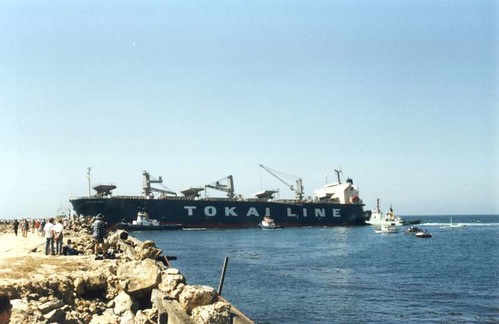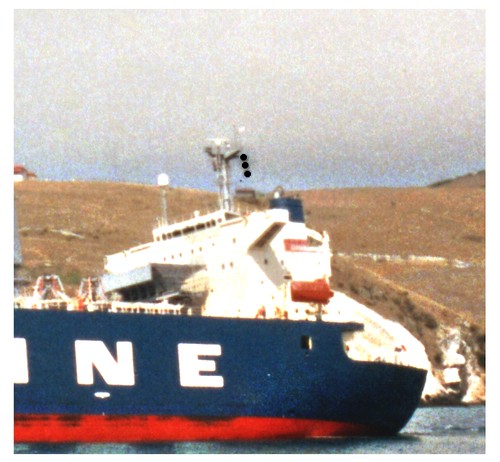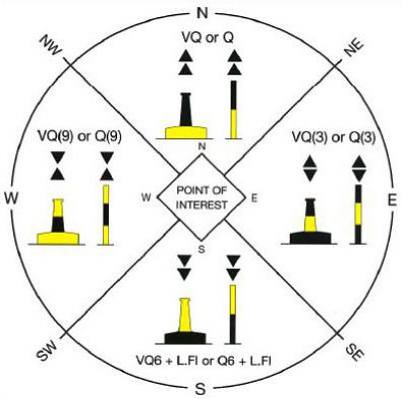 This is a navigational device for mariners called a Cardinal Mark and it indicates what side it should be passed on. Obviously this one must be passed on the EAST side as the consequences of passing it on the South or West sides would be spectacular to say the least! Here are a couple of photos of a ship that tried to do exactly that on the 12th February 1999. The three black balls in a vertical line above the bridge mean “I am not under command and am aground.” Could this be where the expression "balls up" came from?? She remained aground for three days until four tugs pulled her free on a high tide after three attempts.
This is a navigational device for mariners called a Cardinal Mark and it indicates what side it should be passed on. Obviously this one must be passed on the EAST side as the consequences of passing it on the South or West sides would be spectacular to say the least! Here are a couple of photos of a ship that tried to do exactly that on the 12th February 1999. The three black balls in a vertical line above the bridge mean “I am not under command and am aground.” Could this be where the expression "balls up" came from?? She remained aground for three days until four tugs pulled her free on a high tide after three attempts.


A pictorial description of all four Cardinal Marks and their light configurations is shown below. The two triangles for north and south are self explanatory and the East triangles form a sort of an (E)gg while the two triangles for West form a sort of a (W). The light flash configurations follow the hour hand of the clock 
Aromoana Mole
Aramoana, also known as "The Spit" to locals, is a small coastal settlement, 27 kilometres north of Dunedin city, in the South Island of New Zealand. The settlement's permanent population in 2001 Census was 261. Supplementing this are seasonal visitors from the city who occupy cribs. The name Aramoana is Maori for "pathway to the sea". Originally founded by The Otago Harbour Board, established in the 1880s as an ideal pilot station for navigation around the mouth of the Otago Harbour, this area grew into a small farming village. In the 1950s the town became popular as a beach resort and a rural life village due to the construction of a mole, to inhibit the spread of tidal sands into the mouth of the Otago Harbour and was surveyed and amalgamated as a suburb of Port Chalmers borough. It is the site of New Zealand's deadliest criminal shooting, which occurred on 13 and 14 November 1990. The settlement is located on a sand dune Spit at the mouth of the Otago Harbour, opposite the end of the Otago Peninsula. The main channel of the harbour is kept clear by the Aramoana mole, an artificial breakwater which extends for 1200 metres from Aramoana. The mole was originally intended to extend another 600 meters into the ocean, however due to tidal patterns and the instability of the construction, no attempt to extend beyond the current length was thought to be possible. Aramoana Mole has a maximum diving depth of around 20 m / 65.6 ft and is suitable for all divers. The average visibility is 10-20 metres and access to the dive site is by shore. This makes a great site for night diving.
More Information
Aramoana Mole is New Zealand's first man-made underwater structure built as a breakwater in 1885. This wall was built to redirect water entering Otago Harbour and reduce the build up of silt. Several ships have been scuttled along the harbour stretch of the Mole to help protect the structure creating a long chain of underwater wrecks, many of which can be penetrated. These wrecks are encrusted with dense invertebrate life including bladder kelp, algae, ascidians, sponges, sea tulips and starfish. Crayfish and paua are often found in the dark recesses as well as leatherjackets, spotties and banded wrasse. Often schools of blue moki are found in the old ships' hulls. The vessels scuttled here are Mokoia, Paloona, Moana, Kahika, Pateena, Gertie, Plucky and the Otago Dry Dock. Access is from the shore, maximum depth is about 20m although you are not likely to pass 15m, there can be a slight current at times. Visibility is best at high tide at when conditions are not north or northeasterly.
The Cache
A walk along to the end of the mole is a nice thing to do regardless of the weather. In fine weather there are many varieties of sea birds to be seen and of course the fur seals and if there is a shipping movement you can watch the pilot boarding or leaving a ship. Take a pair of binos to observe the Royal Albatrosses and Stewart Island Shags on Taiaroa Head. The cache is very close to the walking path in all three dimensions. There is only room in the cache for the log so bring your own pen.
PLEASE NOTE THAT THE CACHE IS WELL AWAY FROM FUR SEAL HAUL-OUT AREAS BUT IF THEY ARE PRESENT AT GZ THEN THEY HAVE EVERY RIGHT OF WAY. COME BACK ON ANOTHER DAY
The cache is not right at the end of the mole since in heavy easterly or north easterly weather it would be unwise to go there unless you are keen on an unexpected swim. If you need confirmation of this go to: https://www.youtube.com/watch?v=Vhm07FlFvXE. In these conditions one comes away with an appreciation of the awesome power of the sea. Keep a close eye on the kids while looking for the cache.